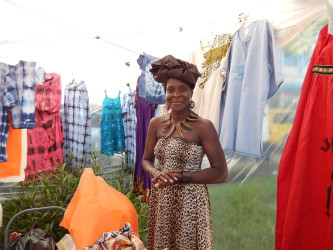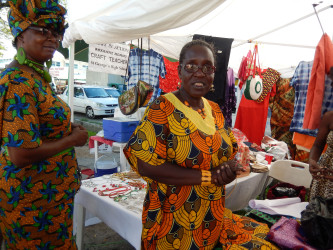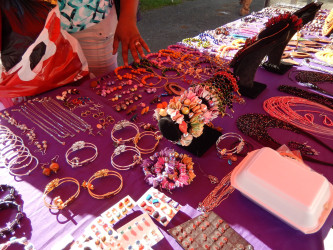For about a week leading up to the annual Emancipation anniversary, before thousands of Guyanese, Brazilians and visitors from the Caribbean and the North American diaspora converge in the National Park to celebrate, the Main Street Avenue comes alive.

Craft producers, seamstresses and vendors specializing in afro-centric clothing and accessories set up tents between Church and Quamina streets to sell clothing, beaded jewellery, African-Guyanese food and indigenous beverages.
Seamstresses come with already treated (starched) pieces to create intricate head wraps to match or contrast with the distinctly patterned fabrics on sale. They attract sizeable crowds every day. In recent years they added makeshift dressing rooms to their temporary tents to body-wrap and otherwise dress a growing number of women and girls in styles specific to Ghana, Nigeria and Senegal mainly. Others just wing it and create their own distinctive styles.
Colourful displays of beaded jewellery and scarves dot this one-block landscape and attract a steady flow of patrons, some of whom are in search of specific colours of earrings, necklaces and arm bands to match or contrast with their chosen fabrics.
When Stabroek Business visited on Emancipation eve, the avenue was teeming with early afternoon shoppers and models fully attired in African regalia. Some people were looking for advice on wrapping techniques. Others wanted to purchase matching outfits for their husbands and sons who would join them in the National Park the following day.
Business was bright and vendors were pleased that the effort was not in vain. They were generally satisfied with the revenue they earned. They planned to return to the location during the morning hours of Emancipation Day to cater to the customers who needed help with body and head wrapping and the last-minute shoppers before heading down to the park to display and sell the remaining items there.

“We do brisk business at the Park because people still want to wear their African outfits after Emancipation, throughout the whole of August,” one vendor offered. Another said that there are a lot of weddings in Guyana in this month and many brides choose an African theme. She was reluctant to give her name but said that the vendors exchange contact information with shoppers so they could provide the desired fabrics, dresses, hand-painted shirts and skirts, or tie-dyed combination outfits for men, women, girls and boys for the particular occasion on the shoppers’ calendars.
Some people go to the Avenue in search of authentic garments from Ghana or Nigeria, Kenya or South Africa. These are expensive since they are generally imported from the African emporiums in nearby Trinidad, from Manhattan or Brooklyn, USA. Ghanian caftan with distinctive golden threadwork at the neckline and sleeves could retail for as much as $29,000. The price however, tends to go down by as much as half during this Emancipation season when local distributors have these items in plentiful supply.
Stabroek Business wanted to know whether the vendors had sufficient motivation to set up their tents in the Avenue on other holidays or occasions. Arts and Craft Teacher at St George’s High School, Roxanne Adams, aka ‘The Mauby Lady’ said that she is present in her spot opposite Courts Furniture Store almost every Saturday throughout the year. During the August holidays and often at Christmas time she is also there in rain or shine.

Apart from her ubiquitous mauby, she makes and sells tibisiri bags and trinkets, place mats and coasters, hot-pot mats made from coconut branches, and lacquered jewellery boxes. Tourists, she said, prefer the items, even tote bags, in their natural state minus the lacquer.
Some of the artifacts she had on display included simple beaded necklaces and arm bands were made by her students. She told the story of the school’s elevation from Community High status to a High School which had everything to do with the students’ performance in the CXC Visual Arts examination. The course had been introduced to the school in 1996 by then Headmaster Erwin Joseph. He then took the initiative to utilize the school’s funds to pay the CXC Examination fees for six students and two teachers, to procure past papers and drawing, painting and craft materials. Every candidate secured a Grade II pass that year. The subject was inserted into the school’s curriculum and the Education Ministry changed the school’s status.
Adams’s sister, Darla, is an experienced, well-travelled fashion designer whose outlook is almost entirely afro-centric. She makes what she wears and attracted much attention on Emancipation Eve in the Avenue. Her specialties are hand painted cross-gender clothing, body and head wrapping which she taught herself. Darla had participated in the African segment of Guyana’s first Fashion Weekend in 2007. She took her designs to the 2008 Caribbean Gift and Craft Show in Barbados, and the following year to a festival in Boa Vista, Brazil. She has been present at Suriname’s fashion events and used it to her advantage. Her contacts there supply her with African garments including very intricate head wraps. She taught herself by “loosing down every one and wrapping them again”. Eventually after much practice, she was able to create her own wrapping styles for head and body.
This Darla says is her bread and butter. Together with her work in cosmetology which she has been engaged in for some 36 years, she earns enough for her family of two children to live comfortably on. She said that she has never worked at anything else in her adult life.
She has built up a considerable client base and word of her skill gets passed around. She says that she receives orders for all kinds of designs for African clothing for adults and children all year round. She spoke about the special events observed by the various Rastafarian tribes in the city and as far away as Berbice and the Hinterland regions, and about the numerous orders she gets for clothing and cosmetic services for African concept weddings, birthday parties and other celebrations and observances.
However, she goes to the Main Street Avenue only on the days prior to the Emancipation anniversary which she uses primarily to meet prospective clients and sell her combination services.




